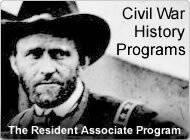
John A. Logan, Citizen Soldier by Susan Claffey
The Smithsonian Associates Civil War E-Mail Newsletter, Volume 9, Number 6
Although he devoted his political career to serving Illinois, Union General John A. Logan is buried at the Soldiers Home National Cemetery next to the Soldiers and Airmen’s Home here in Washington DC.
Yes, that “Logan Circle” Logan and the one responsible for Memorial Day. Logan was born February 9, 1826, in what is now Murphysboro, Illinois. Logan volunteered for the Mexican War in 1846. He saw no combat, but did travel to Santa Fe, where he served as post quartermaster.
The 1850's brought many changes in Logan's life -- law school at Louisville University; marriage to Mary S. Cunningham; a move to Benton, IL; and a political career that led from county clerk to U.S. Congressman. Southern Illinois was known as “Little Egypt” and Logan was "Egypt's spokesman."
At the onset of the Civil War, the formerly pro-Southern Logan decided that, "the union must prevail." He fought at Bull Run as a civilian. He then returned home where his speech at Marion, IL ended Egypt's talk of secession and put southern Illinois strongly in the Union camp.
Logan volunteered for the war and rose from colonel to major general. Fighting in eight major campaigns, he distinguished himself at Vicksburg and commanded the entire Union force at the Battle of Atlanta. At the war's end, he saved Raleigh, NC from being burned by angry Union troops. Many historians consider him the premier volunteer general of the Civil War.
After the war, Logan returned to Congress. He was the national commander of the Grand Army of the Republic. His concern for veterans led him to take part in Illinois' first organized veterans memorial services at Woodlawn Cemetery in Carbondale in 1866. On May 5, 1868, he officially proclaimed the first official Memorial Day in his General Order No. 11. It was first observed on 30 May 1868, when flowers were placed on the graves of Union and Confederate soldiers at Arlington National Cemetery, as a national holiday.
In 1871 and again in 1874, Logan was elected to the U.S. Senate. In 1884, he was James G. Blaines' vice-presidential running mate. During the campaign, Logan commissioned the painting that became the center for Atlanta's famed Cyclorama. John A. Logan died December 26, 1886, in Washington D.C., and he lies in a mausoleum at Soldiers Cemetery.
Logan's fame did not die with him as there are many towns and counties named for him. Fine equestrian statues were erected in Chicago and Washington in his honor. Bronze plaques from Arlington Cemetery to Denver attest to his role in establishing Memorial Day. While today Logan’s fame has faded, many still stop by and pay their respects, especially on Memorial Day.

Our thanks (once again) to Ms. Susan Claffey for this article. Susan is Director of Contracting for Group Services of America’s Blood Centers, holds an MBA, and is past president of the Civil War Roundtable of the District of Columbia.

